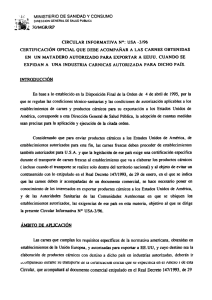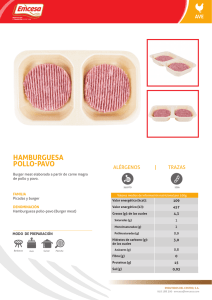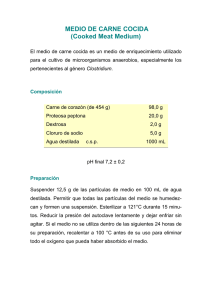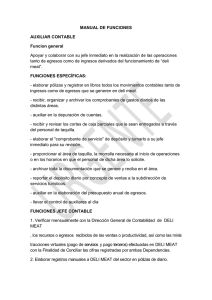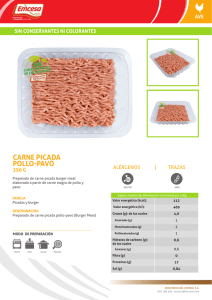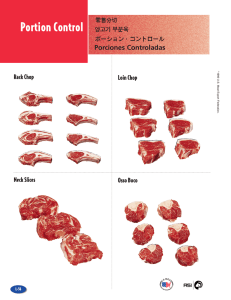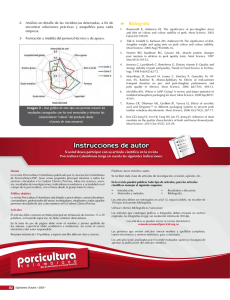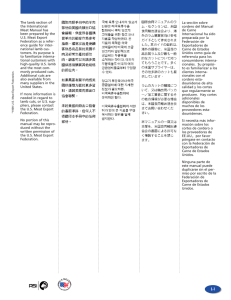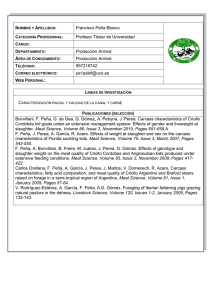Beef Offal
Anuncio
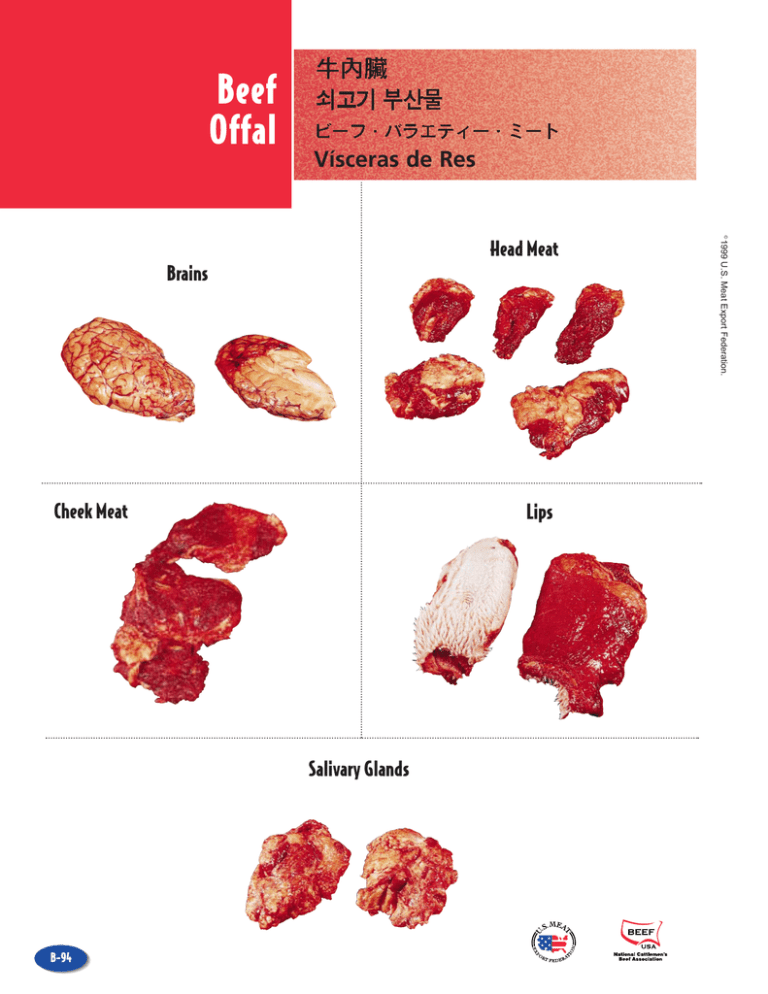
Beef Offal Vísceras de Res © Brains Cheek Meat Lips Salivary Glands B-94 1999 U.S. Meat Export Federation. Head Meat Brains Sesos Beef brains are located in the front of the skull and are compact and circular in shape. Los sesos de la res están localizados en la parte frontal del cráneo siendo su forma circular y compacta. © 1999 U.S. Meat Export Federation. Head Meat Head meat is the meat that remains on the skull after the removal of the skin, cheeks, tongue and lips. Carne de la Cabeza La carne de la cabeza es la carne que permanece en el cráneo después de quitar la piel, los cachetes, la lengua y los labios. Cheek Meat Cheek meat is generated from the jaw area of the head and is trimmed of visible glandular material. Carne de Cachete La carne de cachete se produce del área de las mandíbulas. Se le quita todo el material glandular visible. Lips Lips are generated from the head and consist of the firm muscular front portion of the mouth. Labios Los labios se obtienen de la cabeza y consisten del músculo firme de la parte frontal de la boca. Salivary Glands Salivary glands are the interior lining of the cheek and includes the gland. Glándulas Salivales Las glándulas salivales son el recubrimiento interior de la mejilla. Incluyen la glándula. B-95 Tongue Weasand © 1999 U.S. Meat Export Federation. Sweetbreads Heart Liver B-96 1999 U.S. Meat Export Federation. © Tongue Lengua The tongue may be harvested with the bone, root and blade meat attached. The purchaser may specify Swiss cut tongues which are practically free of fat and have the bone, glands and underlying blade meat removed. La lengua se puede obtener con el hueso, la raíz y la carne de la paleta adheridas. El comprador puede pedirlas con corte Suizo que no incluyen casi nada de grasa y se les quita el hueso, las glándulas y la carne por debajo del hueso de la paleta. Weasand The weasand is the lean muscle tissue of the esophagus. Tráquea La tráquea es el músculo delgado del esófago. Sweetbreads The sweetbread is the thymus gland. It is a white pinkish gland found in the neck area. Mollejas La molleja es la glándula del timo de color blanco rosado que se encuentra en el área del cuello. Heart The heart is a large muscular organ found in the thorax region. Hearts may be purchased with the cap present or absent. Cap-on hearts are surrounded by semi-hard white colored fat. Cap-off hearts will be trimmed of visible fat and have the cap meat and bone removed. Liver Livers will generally have all ducts, blood vessels, lymph nodes and connective tissues trimmed even with the surface of the organ. Corazón El corazón es un órgano que consiste de un músculo grande localizado en la región del tórax. Los corazones pueden comprarse con o sin la tapa. Los corazones con tapa están rodeados de grasa semidura color blanco. A los corazones sin tapa se les recorta toda la grasa visible y se les quita la carne de la tapa y el hueso. Hígado Al hígado por lo general se le recorta a nivel de los ductos, vasos sanguíneos, nódulos linfáticos y tejido conectivo. B-97 Honeycomb Tripe (Reticulum) Rumen © 1999 U.S. Meat Export Federation. Bible Tripe (Omassum) B-98 1999 U.S. Meat Export Federation. © Rumen Rumen/Panza The rumen is the first and largest stomach of ruminant animals. The rumen may be purchased scalded and bleached (shown) or scalded with no chemicals (not shown). La Rumen/Panza es el primero y más grande estómago de la res. Puede comprarse escaldado y blanqueado (se muestra) o escaldado sin substancias químicas (no se muestra). Honeycomb Tripe (Reticulum) Panal o Cacariso (retículo) The reticulum or honeycomb tripe is the second stomach of ruminant animals. The interior of the reticulum has the appearance of a honeycomb. El retículo, panal, o cacariso es el segundo estómago de los rumiantes. El interior del retículo tiene la apariencia de un panal de abeja. Bible Tripe (Omasum) Libro (Omaso) Omasum or bible tripe is the third stomach of ruminant animals. Bible tripe has a leaf-like appearance from which its name originates. El omaso o libro es el tercer estómago de los rumiantes. Esta tiene tiene una apariencia como si fueran hojas de donde se origina su nombre. Abomasum Abomaso Abomassum is the fourth and true stomach of ruminant animals (not shown). Es el cuarto estómago y verdadero estómago de los rumiantes (no se muestra). B-99 Kidney Pancreas Gland © 1999 U.S. Meat Export Federation. Small Intestine Testicles (Fries) B-100 Large Intestine Pizzle Kidney Riñón Kidneys are found next to the primal loin in the interior of the carcass. Kidneys are trimmed even to their surface of all blood vessels and excess fat. Los riñones están localizados enseguida del lomo principal. Los vasos sanguíneos y el exceso de grasa se recortan a nivel de los riñones. Glándula del Páncreas © 1999 U.S. Meat Export Federation. Pancreas Gland The pancreas gland is found near the liver and is similar in shape to the sweetbread but is more irregular. La glándula del páncreas está localizada cercas del hígado y su forma es parecida a la molleja pero más irregular. Small Intestine Intestino Delgado The small intestine is the part of the digestive tract that connects the stomach and the large intestine. The small intestine is long and tubular in shape. El intestino delgado es la parte del tracto digestivo conectado al estómago y el intestino grueso. El intestino delgado es largo de forma tubular. Large Intestine Intestino Grueso The large intestine is the part of the digestive tract that connects the small intestine to the rectum. The large intestine is tubular in shape when harvested but is typically sectioned and split during processing. El intestino grueso es la parte del tracto digestivo conectado al intestino delgado y el recto. El intestino grueso es tubular cuando se extrae pero por lo general se separa en secciones durante el procesamiento. Testicles (Fries) Testículos/Creadillas Testicles are typically referred to as fries and are harvested from male animals. Los testículos se extraen de los animales machos. Vergajo o Viril Pizzle The pizzle is the penis that is harvested from male animals. It is long and tubular in shape and has a heavy fibrous casing. El vergajo es el pene en los animales macho. Es largo y tubular con un revestimiento fibroso. B-101 Back Strap Tunic Tissue © 1999 U.S. Meat Export Federation. Skirt Sinew Achilles Tendon B-102 Flexor Tendon Oxtail 1999 U.S. Meat Export Federation. © Back Strap Banda Posterior The back strap is obtained from the chuck and rib sections of the carcass. This tissue is a strong elastic-like substance that is yellow in color. Back strap obtained from the chuck sections are more uniform in shape than the sections obtained from the rib. La banda posterior se produce de las secciones de la espaldilla y costillar de la canal. El tejido es una substancia elástica resistente de color amarillo. Las bandas que se extraen de las secciones de la espaldilla son de una forma más uniforme que las que se extraen del costillar. Tunic Tissue Tejido de Túnica Tunic tissue is an elastic, yellow and white colored tissue that originates along the interior of the carcass. This tissue is thin and triangular in shape. El tejido de túnica es un tejido elástico de color blanco y amarillo que se origina a lo largo de la canal de una forma triangular. Nervio de la Falda Skirt Sinew Skirt sinew is a connective tissue that attaches the diaphragm (outside skirt) to the pillar of the diaphragm (hanging tender). It is composed of elastic and fibrous tissues. Flexor Tendon Beef flexor tendons are harvested from the front legs. They are white in color. Achilles Tendon The achilles tendon is a large tendon located in the hind legs of an animal. The achilles tendon in beef cattle is yellow in color and is often referred to as the gambrel cord. Oxtail The oxtail is trimmed of excess fat and may be specified whole or disjointed. Tallow Tallow is the hard fat or suet that has been heat processed. It may be used to produce an edible or an inedible product (not shown). El nervio de la falda es un tejido conectivo que une el diafragma (falda exterior) con el pilar del diafragma (filete). Está compuesto de tejido elástico y fibroso. Tendón Flexor Los tendones flexores se extraen de las patas delanteras. Su color es blanco. Tendón de Aquiles El tendón de Aquiles es un tendón grande ubicado en las patas traseras del animal. En el ganado de res es de color amarillo y con frecuencia se le llama corvejón. Cola A la cola se le recorta el exceso de grasa. El comprador puede especificar si las quiere enteras o separadas por vértebra. Sebo El sebo es la grasa dura que se ha procesado con calor. Se puede usar para producir productos comestibles o no comestibles (no se muestra). B-103
